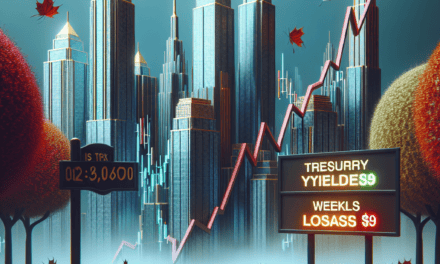“Market Stagnation Looms: Fed Uncertainty and Debt Concerns Cast a Shadow on Stocks”
Introduction
In a climate of economic ambiguity, market experts are sounding alarms over the potential stagnation of stock markets, driven by uncertainties surrounding Federal Reserve policies and escalating concerns over the United States’ mounting debt. As investors grapple with the implications of fluctuating interest rates and fiscal instability, the stock market faces a precarious period marked by volatility and cautious sentiment. This analysis delves into the factors contributing to the anticipated stagnation, exploring how the interplay between monetary policy and national debt could shape market trajectories in the coming months.
Impact Of Federal Reserve Policies On Stock Market Stability
The stability of the stock market is intricately linked to the policies of the Federal Reserve, which plays a pivotal role in shaping economic conditions through its monetary policy decisions. Recently, market experts have expressed concerns about the potential stagnation of stocks, attributing this to the prevailing uncertainty surrounding the Federal Reserve’s future actions and the looming worries over the United States’ debt situation. As investors navigate these turbulent waters, understanding the impact of Federal Reserve policies on stock market stability becomes increasingly crucial.
To begin with, the Federal Reserve’s monetary policy decisions, particularly those related to interest rates, have a profound influence on the stock market. When the Fed raises interest rates, borrowing costs for businesses and consumers increase, potentially slowing down economic growth. Conversely, lowering interest rates can stimulate economic activity by making borrowing cheaper. However, the current economic landscape presents a complex scenario. On one hand, inflationary pressures have prompted discussions about potential interest rate hikes to curb rising prices. On the other hand, concerns about economic growth and employment levels necessitate a cautious approach to avoid stifling recovery efforts.
Adding to this complexity is the uncertainty surrounding the Federal Reserve’s future policy direction. Market participants are keenly observing the Fed’s communications for any hints of policy shifts. This uncertainty can lead to increased market volatility as investors react to perceived signals from the Fed. The lack of a clear trajectory in monetary policy can result in hesitation among investors, leading to a stagnation in stock market activity as they adopt a wait-and-see approach.
Moreover, the issue of the United States’ national debt further complicates the situation. The growing debt levels have sparked debates about fiscal sustainability and the potential implications for the economy. Concerns about the government’s ability to manage its debt obligations can lead to apprehension among investors, who may fear that excessive borrowing could eventually lead to higher taxes or reduced government spending. Such fiscal uncertainties can weigh heavily on investor sentiment, contributing to a cautious stance in the stock market.
In light of these factors, market experts are predicting a period of stagnation for stocks. The interplay between Federal Reserve policies and fiscal concerns creates an environment where investors may be reluctant to make significant moves. This cautious sentiment is further exacerbated by the global economic landscape, which is still grappling with the aftermath of the COVID-19 pandemic. Supply chain disruptions, labor market challenges, and geopolitical tensions add layers of complexity to the already uncertain economic outlook.
In conclusion, the impact of Federal Reserve policies on stock market stability cannot be overstated. The current environment, characterized by uncertainty over interest rates and fiscal concerns, presents a challenging landscape for investors. As they navigate these complexities, the potential for stock market stagnation looms large. While the Federal Reserve’s actions will continue to be closely monitored, the broader economic context, including the management of national debt, will also play a crucial role in shaping investor sentiment. Ultimately, the path to stock market stability will depend on a delicate balance between monetary policy decisions and fiscal responsibility, as well as the ability of policymakers to effectively communicate their strategies to the market.
Navigating Investment Strategies Amidst Economic Uncertainty
In the ever-evolving landscape of financial markets, investors are constantly seeking guidance to navigate the complexities of economic uncertainty. Recently, a prominent market expert has forecasted a period of stagnation for stocks, attributing this outlook to the prevailing uncertainty surrounding the Federal Reserve’s monetary policy and growing concerns over the United States’ national debt. As investors grapple with these challenges, it becomes imperative to explore strategies that can effectively mitigate risks while capitalizing on potential opportunities.
To begin with, the Federal Reserve’s monetary policy plays a pivotal role in shaping market dynamics. The central bank’s decisions regarding interest rates and quantitative easing have far-reaching implications for both the economy and financial markets. Currently, there is considerable ambiguity regarding the Fed’s future course of action. While some analysts anticipate a continuation of accommodative policies to support economic recovery, others warn of potential tightening measures to curb inflationary pressures. This uncertainty has left investors in a state of limbo, as they attempt to gauge the Fed’s next move and its impact on asset prices.
Moreover, the burgeoning national debt of the United States adds another layer of complexity to the investment landscape. With the debt ceiling debates becoming a recurring theme in Washington, concerns about fiscal sustainability are mounting. The potential for a government shutdown or a default on debt obligations could have severe repercussions for financial markets, leading to heightened volatility and investor anxiety. Consequently, market participants are increasingly wary of the potential fallout from these fiscal challenges, further contributing to the anticipated stagnation in stock performance.
In light of these uncertainties, investors are advised to adopt a cautious yet strategic approach to their portfolios. Diversification remains a cornerstone of sound investment strategy, as it helps to spread risk across various asset classes and sectors. By allocating investments across equities, bonds, and alternative assets, investors can better withstand market fluctuations and reduce exposure to any single economic event. Additionally, maintaining a long-term perspective is crucial, as short-term market movements can often be unpredictable and driven by transient factors.
Furthermore, investors should consider incorporating defensive stocks into their portfolios. These are typically companies with stable earnings and strong balance sheets, which tend to perform well even during economic downturns. Sectors such as consumer staples, healthcare, and utilities are often regarded as defensive plays, providing a degree of stability amidst market turbulence. By focusing on these resilient sectors, investors can potentially safeguard their portfolios against the adverse effects of economic uncertainty.
In addition to traditional investment strategies, some investors may explore opportunities in emerging markets or sectors poised for growth. While these investments carry inherent risks, they also offer the potential for higher returns. Conducting thorough research and due diligence is essential when venturing into these areas, as understanding the unique dynamics and challenges of each market is crucial for making informed decisions.
In conclusion, the current economic environment, characterized by Fed uncertainty and US debt concerns, presents a challenging backdrop for investors. However, by employing a diversified and strategic approach, investors can navigate these uncertainties with greater confidence. As the market expert’s prediction of stagnant stocks looms, it is essential for investors to remain vigilant, adaptable, and informed, ensuring that their investment strategies are well-aligned with the evolving economic landscape.
The Role Of US Debt Concerns In Market Performance
In the intricate world of financial markets, the interplay between various economic factors often dictates the performance of stocks. Recently, market experts have been voicing concerns about the potential stagnation of stock markets, attributing this to the prevailing uncertainty surrounding the Federal Reserve’s monetary policy and the burgeoning worries over U.S. debt levels. These two elements, while distinct, are intricately linked and together create a complex environment that investors must navigate with caution.
To begin with, the Federal Reserve’s monetary policy plays a pivotal role in shaping market dynamics. Investors closely monitor the Fed’s decisions on interest rates, as these have direct implications for borrowing costs, consumer spending, and overall economic growth. However, the current climate is marked by uncertainty regarding the Fed’s next moves. With inflationary pressures persisting and economic indicators sending mixed signals, the central bank faces a challenging task in balancing its dual mandate of promoting maximum employment and ensuring price stability. This uncertainty leaves investors in a state of limbo, hesitant to make bold moves in the stock market without clear guidance on the future trajectory of interest rates.
Simultaneously, concerns over U.S. debt levels add another layer of complexity to the market landscape. The national debt has been steadily climbing, exacerbated by pandemic-related spending and ongoing fiscal policies. As the debt ceiling looms, debates in Congress about raising it further intensify, creating a sense of unease among investors. The potential for a government shutdown or, worse, a default on debt obligations could have catastrophic consequences for financial markets, leading to heightened volatility and a loss of investor confidence. This scenario underscores the importance of fiscal responsibility and the need for policymakers to address long-term debt sustainability.
Moreover, the interplay between Fed policy and U.S. debt concerns is not lost on market participants. The Federal Reserve’s actions are often influenced by fiscal policy, and vice versa. For instance, if the government continues to accumulate debt at an unsustainable pace, the Fed may be compelled to adjust its monetary policy to mitigate inflationary pressures. Conversely, if the Fed tightens monetary policy too aggressively, it could stifle economic growth, making it more challenging for the government to manage its debt obligations. This delicate balance further complicates the decision-making process for investors, who must weigh the potential risks and rewards in an environment fraught with uncertainty.
In light of these factors, market experts caution that stock markets may experience a period of stagnation. Investors, wary of the potential pitfalls associated with Fed uncertainty and U.S. debt concerns, may adopt a more conservative approach, opting to hold onto cash or invest in safer assets until clearer signals emerge. This cautious stance could lead to reduced trading volumes and limited upward momentum in stock prices, at least in the short term.
In conclusion, the current market environment is characterized by a confluence of factors that contribute to investor apprehension. The uncertainty surrounding the Federal Reserve’s monetary policy, coupled with mounting concerns over U.S. debt levels, creates a challenging landscape for stock market performance. As investors grapple with these issues, the potential for stagnation looms large, underscoring the need for careful analysis and strategic decision-making in navigating these turbulent times.
Analyzing The Relationship Between Interest Rates And Stock Prices

In the intricate world of finance, the relationship between interest rates and stock prices is a subject of perennial interest and debate. As market dynamics evolve, understanding this relationship becomes crucial for investors seeking to navigate the complexities of the stock market. Recently, a market expert has predicted stagnant stock performance, attributing this outlook to the prevailing uncertainty surrounding Federal Reserve policies and growing concerns over the United States’ national debt. This prediction underscores the intricate interplay between interest rates and stock prices, a relationship that is both direct and nuanced.
Interest rates, set by the Federal Reserve, serve as a fundamental tool for regulating economic activity. When the Fed adjusts interest rates, it influences borrowing costs, consumer spending, and business investment. Typically, lower interest rates reduce the cost of borrowing, encouraging businesses to invest and consumers to spend, thereby stimulating economic growth. Conversely, higher interest rates can dampen economic activity by making borrowing more expensive, which can lead to reduced spending and investment. This dynamic directly impacts stock prices, as corporate earnings and economic growth prospects are key drivers of market valuations.
In periods of low interest rates, stocks often benefit from increased investment as investors seek higher returns than those offered by fixed-income securities. However, the current landscape is marked by uncertainty regarding the Fed’s future actions. With inflationary pressures persisting, the central bank faces the challenge of balancing economic growth with price stability. This uncertainty can lead to market volatility, as investors speculate on the timing and magnitude of potential rate hikes. Such speculation can result in erratic stock price movements, as market participants adjust their portfolios in anticipation of changing economic conditions.
Moreover, the looming issue of the United States’ national debt adds another layer of complexity to the relationship between interest rates and stock prices. As the national debt continues to grow, concerns about fiscal sustainability and potential impacts on economic stability become more pronounced. High levels of debt can lead to increased borrowing costs for the government, which may, in turn, influence interest rates across the economy. If investors perceive the national debt as unsustainable, it could lead to higher risk premiums, affecting both government and corporate borrowing costs. This scenario could exert downward pressure on stock prices, as higher interest rates would likely reduce corporate profitability and economic growth prospects.
In light of these factors, the market expert’s prediction of stagnant stock performance appears grounded in a cautious assessment of the current economic environment. The interplay between interest rates and stock prices is not merely a matter of direct cause and effect; it is influenced by a myriad of factors, including investor sentiment, economic indicators, and geopolitical developments. As such, investors must remain vigilant and adaptable, recognizing that the relationship between interest rates and stock prices is dynamic and subject to change.
In conclusion, the prediction of stagnant stocks due to Fed uncertainty and US debt worries highlights the intricate relationship between interest rates and stock prices. As the Federal Reserve navigates the challenges of managing inflation and economic growth, and as concerns over national debt persist, investors must carefully consider these factors when making investment decisions. By understanding the multifaceted nature of this relationship, investors can better position themselves to respond to the evolving economic landscape and make informed choices in an uncertain market environment.
Expert Insights On Managing Portfolios During Economic Stagnation
In the current economic climate, investors are navigating a complex landscape marked by uncertainty surrounding Federal Reserve policies and growing concerns over the United States’ national debt. Market experts are increasingly predicting a period of stagnation for stocks, a scenario that requires strategic adjustments in portfolio management. Understanding the implications of these economic factors is crucial for investors aiming to safeguard their assets and optimize returns during this challenging period.
The Federal Reserve’s monetary policy plays a pivotal role in shaping market dynamics. Recently, the Fed has been caught in a delicate balancing act, attempting to curb inflation without stifling economic growth. This has led to a series of interest rate hikes, which, while intended to stabilize prices, have also introduced volatility into the stock market. Investors are left in a state of uncertainty, as the Fed’s future actions remain unpredictable. This unpredictability can lead to cautious behavior among investors, who may choose to hold off on making significant investment decisions until a clearer picture emerges.
Compounding this uncertainty is the issue of the United States’ national debt, which has reached unprecedented levels. The growing debt burden raises concerns about the country’s fiscal health and its ability to meet future obligations. This situation is further exacerbated by political gridlock, which often hampers efforts to implement effective fiscal policies. As a result, investors are wary of potential economic repercussions, such as increased taxes or reduced government spending, which could negatively impact corporate earnings and, consequently, stock prices.
In light of these challenges, market experts advise a cautious approach to portfolio management. Diversification remains a key strategy, as it helps mitigate risk by spreading investments across various asset classes. By including a mix of stocks, bonds, and alternative investments, investors can better withstand market fluctuations. Additionally, focusing on high-quality, dividend-paying stocks can provide a steady income stream, offering some protection against market downturns.
Another important consideration is maintaining liquidity within a portfolio. In times of economic uncertainty, having access to cash or cash-equivalent assets can provide flexibility and enable investors to capitalize on opportunities as they arise. This approach also allows for quick adjustments in response to changing market conditions, which is particularly valuable when navigating a stagnant market.
Moreover, investors should pay close attention to global economic trends, as these can have significant implications for domestic markets. For instance, geopolitical tensions or shifts in international trade policies can influence investor sentiment and impact stock performance. By staying informed about global developments, investors can make more informed decisions and adjust their portfolios accordingly.
In conclusion, the current economic environment, characterized by Fed uncertainty and concerns over national debt, presents significant challenges for investors. However, by adopting a strategic approach to portfolio management, focusing on diversification, maintaining liquidity, and staying informed about global trends, investors can navigate this period of stagnation more effectively. While the path forward may be fraught with uncertainty, a well-considered strategy can help mitigate risks and position investors for long-term success. As always, consulting with financial advisors and staying abreast of market developments are prudent steps in managing portfolios during these uncertain times.
Long-Term Implications Of Federal Reserve Decisions On Investors
In the ever-evolving landscape of financial markets, investors are constantly seeking to understand the long-term implications of Federal Reserve decisions. Recently, market experts have voiced concerns about stagnant stock performance, attributing this to the prevailing uncertainty surrounding the Federal Reserve’s monetary policy and the looming specter of U.S. debt. As these factors intertwine, they create a complex environment that demands careful consideration from investors aiming to navigate the turbulent waters of the stock market.
To begin with, the Federal Reserve plays a pivotal role in shaping economic conditions through its monetary policy decisions. By adjusting interest rates and engaging in open market operations, the Fed influences borrowing costs, consumer spending, and ultimately, economic growth. However, when the Fed’s future actions are shrouded in uncertainty, it can lead to market volatility and investor hesitation. This uncertainty often stems from the Fed’s dual mandate of promoting maximum employment and maintaining stable prices, which can sometimes be at odds with each other. As a result, investors find themselves in a precarious position, trying to anticipate the Fed’s next move and its potential impact on their portfolios.
Moreover, the issue of U.S. debt further complicates the investment landscape. The national debt has been a growing concern for years, and its implications for the economy are profound. High levels of debt can lead to increased borrowing costs, reduced fiscal flexibility, and potential downgrades in credit ratings. These factors can, in turn, affect investor confidence and market stability. When combined with the uncertainty surrounding the Federal Reserve’s actions, the situation becomes even more challenging for investors seeking long-term growth.
In light of these challenges, it is crucial for investors to adopt a strategic approach that takes into account both the current economic environment and potential future developments. Diversification remains a key strategy, as it allows investors to spread risk across various asset classes and sectors. By doing so, they can mitigate the impact of any adverse developments in specific areas of the market. Additionally, maintaining a long-term perspective is essential, as short-term market fluctuations can often be misleading and may not accurately reflect the underlying economic fundamentals.
Furthermore, staying informed about the Federal Reserve’s policy decisions and the broader economic context is vital for making informed investment choices. Investors should pay close attention to the Fed’s communications, such as meeting minutes and press conferences, to gain insights into its policy direction. Understanding the rationale behind the Fed’s decisions can help investors anticipate potential market reactions and adjust their strategies accordingly.
In conclusion, the current environment of Fed uncertainty and U.S. debt concerns presents significant challenges for investors. However, by adopting a strategic approach that emphasizes diversification, long-term thinking, and staying informed, investors can better navigate these complexities. While the path forward may be fraught with uncertainty, a well-considered investment strategy can help mitigate risks and position investors for success in the long run. As market conditions continue to evolve, remaining adaptable and vigilant will be key to achieving favorable outcomes in the face of these ongoing challenges.
Understanding The Connection Between National Debt And Market Trends
The intricate relationship between national debt and market trends has long been a subject of analysis and debate among economists and investors alike. As market experts predict stagnant stocks due to Federal Reserve uncertainty and growing concerns over U.S. debt, it becomes increasingly important to understand how these elements interact and influence each other. The national debt, which represents the total amount of money that a country’s government has borrowed, can have profound implications for financial markets. When a nation accumulates significant debt, it often leads to increased borrowing costs, as investors demand higher yields to compensate for the perceived risk. This, in turn, can affect the stock market by making it more expensive for companies to finance their operations and growth initiatives.
Moreover, the Federal Reserve plays a crucial role in shaping market trends through its monetary policy decisions. The Fed’s actions, such as setting interest rates and implementing quantitative easing measures, are closely watched by investors as they can significantly impact economic conditions. When the Fed signals uncertainty or hesitancy in its policy direction, it can lead to market volatility and investor apprehension. This uncertainty can be exacerbated by concerns over the national debt, as investors may fear that high levels of debt could limit the Fed’s ability to respond effectively to economic challenges.
In recent times, the U.S. has witnessed a substantial increase in its national debt, driven by factors such as expansive fiscal policies and pandemic-related expenditures. This surge in debt has raised alarms about the country’s fiscal sustainability and its potential impact on the economy. As the debt continues to grow, questions arise about the government’s ability to service its obligations without resorting to inflationary measures or austerity policies, both of which could have adverse effects on the stock market.
Furthermore, the interplay between national debt and market trends is not limited to domestic factors. Global investors closely monitor the U.S. debt situation, as it can influence international capital flows and currency valuations. A high level of national debt may lead to a depreciation of the U.S. dollar, affecting the competitiveness of American exports and potentially leading to trade imbalances. These dynamics can create additional layers of complexity for investors trying to navigate the stock market.
In light of these considerations, market experts are increasingly cautious about the outlook for stocks. The combination of Fed uncertainty and mounting debt concerns creates an environment where investors may be hesitant to commit significant capital to equities. This cautious sentiment can lead to stagnant stock prices, as market participants await clearer signals from policymakers and a more stable economic backdrop.
In conclusion, understanding the connection between national debt and market trends is essential for investors seeking to make informed decisions. The intricate interplay between these factors can have far-reaching implications for financial markets, influencing everything from interest rates to currency valuations. As the U.S. grapples with its debt challenges and the Federal Reserve navigates a complex economic landscape, market participants must remain vigilant and adaptable. By closely monitoring these developments, investors can better position themselves to respond to potential shifts in market dynamics and capitalize on emerging opportunities.
Q&A
1. **Question:** What is the primary reason for the predicted stagnation in the stock market?
**Answer:** The primary reason for the predicted stagnation in the stock market is uncertainty surrounding the Federal Reserve’s monetary policy decisions.
2. **Question:** How does US debt contribute to stock market concerns?
**Answer:** US debt contributes to stock market concerns by creating economic instability and potential for increased interest rates, which can negatively impact corporate profits and investor confidence.
3. **Question:** What role does the Federal Reserve play in influencing stock market trends?
**Answer:** The Federal Reserve influences stock market trends through its monetary policy decisions, such as setting interest rates and implementing quantitative easing or tightening, which affect borrowing costs and economic growth.
4. **Question:** What are investors worried about regarding the Federal Reserve’s actions?
**Answer:** Investors are worried about the timing and magnitude of the Federal Reserve’s interest rate hikes and other policy measures, which could slow down economic growth and affect stock valuations.
5. **Question:** How might stagnant stock markets impact individual investors?
**Answer:** Stagnant stock markets might impact individual investors by limiting potential returns on investments, increasing volatility, and making it more challenging to achieve financial goals.
6. **Question:** What sectors might be most affected by the uncertainty in Fed policy and US debt issues?
**Answer:** Sectors most affected might include financials, due to interest rate sensitivity, and consumer discretionary, as economic uncertainty can lead to reduced consumer spending.
7. **Question:** What strategies might market experts recommend to navigate this period of uncertainty?
**Answer:** Market experts might recommend strategies such as diversifying portfolios, focusing on defensive stocks, increasing cash reserves, and considering alternative investments to mitigate risk during periods of uncertainty.
Conclusion
The market expert’s prediction of stagnant stocks is primarily driven by two significant factors: uncertainty surrounding the Federal Reserve’s monetary policy and concerns over the rising US debt levels. The Fed’s potential interest rate adjustments create an unpredictable environment, causing investors to hesitate in making bold market moves. Simultaneously, the growing US debt raises fears of fiscal instability, which could lead to reduced investor confidence and spending. Together, these elements contribute to a cautious market outlook, with investors likely adopting a wait-and-see approach until clearer economic signals emerge.





